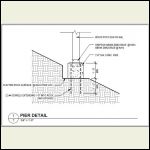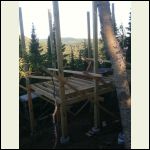|
| Author |
Message |
Ontario lakeside
Member
|
# Posted: 30 Jan 2013 01:23pm
Reply
Hey all
I'm designing the foundation piers for our 500sf cabin. We will be building on exposed bedrock. My plan is to drill and expoxy metal conectors that whould normally be used on the top of a masonry pier but directly bolted to the rock. These would then support 6x6 PT posts.
The alternative is to drill rebar into the rock and pour a pier then mount the connector.
Seems to me that the direct connection would be simpler and less problematic in the future.
I would love to hear from anyone who has done something similar.
Thanks
|
|
bldginsp
|
# Posted: 30 Jan 2013 02:39pm
Reply
Never done anything similar, but I would go the route of pouring concrete piers onto rebar drilled into the rock. Only because you are then lifting the wood off the ground, so it will be less likely to rot. If you just bolt connectors to the rock, your wood can't be more than 1" from the ground. You always want your wood at least 6" above the ground for longevity, more if possible.
Using epoxy to set the rebar (or bolts) in the rock would also give you good uplift resistance, if you are in a seismic zone. Otherwise it's probably unnecessary because all the rebar is doing is preventing lateral shifting, in which case you can just cement it in place.
But rather than piers you might also consider a spread footing, or continuous wall of concrete on the bedrock around the perimeter of the building. Takes a lot more concrete, but then you have a far more stable building and you don't have to buy as many big beams to support the subfloor. Since you are on rock, you don't have to dig down into the earth, so you'd use far less concrete than a regular spread footing in dirt. But still, it would be a lot of bags of concrete. It would be a permanent building, though.
|
|
Popeye
Member
|
# Posted: 30 Jan 2013 02:53pm - Edited by: Popeye
Reply
If you use epoxy, ensure the holes are cleaned properly. You will need a brush and compressed air to get the dust out of the hole. If you don't do this, the epoxy will not bond to the rock.
|
|
bobbotron
Member
|
# Posted: 30 Jan 2013 04:33pm
Reply
What bldginsp said!  Stubby concrete piers on the rock would be a nice way to go. Stubby concrete piers on the rock would be a nice way to go.
Rent or buy a rotary hammer (not a hammer drill) to drill the holes in the rock. They are amazing tools, I greatly wish I had bought one instead of my hammer drill. I rented a smaller bosch rotary hammer to drill rebar mounting holes after I was fed up with my hammer drill, the bosch had the job done so quickly.
|
|
ShabinNo5
Member
|
# Posted: 31 Jan 2013 06:25am
Reply
The Shabin is in northern Minnesota near Lake Superior. The bed rock (basalt) is exposed or no more than 20" below the soil.
I have attached the pier drawing from our plans and an early photo of our progress.
Each of our piers contains three pins that were drilled between 12 and 18 inches into the bedrock.
My experiance was that I could drill at a rate of 1" per minute.
Foundation_Pier_Deta.jpg
| 
002.JPG
|  |  |
|
|
bobbotron
Member
|
# Posted: 20 Feb 2013 12:17pm
Reply
Flatten rock surface...  How did you manage that? How did you manage that? 
|
|
ShabinNo5
Member
|
# Posted: 20 Feb 2013 09:39pm
Reply
bobbotron... not as cleanly as the plan suggests. The process involves removing the loose material then shaping by drilling and chiseling. The first one got alot of attention, the remaining piers are set with a looser definition of flat 
I am sure that having the surface of the bedrock flat and level would be best, but I was comfortable with applying a definition of flat being within 10 degrees of level or having the base slant back into the hill side.
|
|
|

